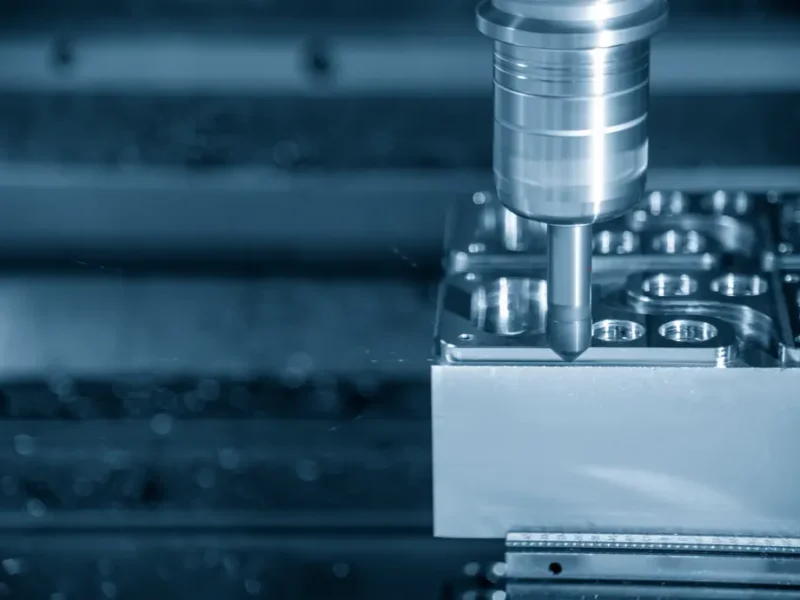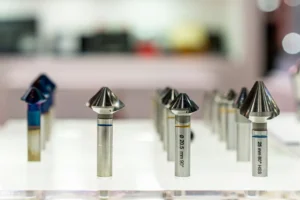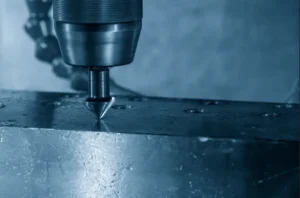
Various edge profiles, including V-shaped, U-shaped, and square-shaped chamfers can be achieved thanks to chamfer milling. The operation can be done using multiple types of cutting tools depending on the setup and the required results. In this article, we will go over the most essential things machinists need to know about Chamfer Milling.
Table of Contents
Chamfering: What It Is and What It Does

Also known as beveling or chamfering milling, chamfering is the process of cutting away a small portion of material from the edge of a workpiece. The cut is usually made at an angle, and the resulting surface is known as a chamfer. By doing so, the two-dimensional chamfer develops a series of gentle angles creating a smooth surface. It is commonly used to prepare the edges of a workpiece for welding or brazing.
Chamfer milling tools are used in architecture, engineering, and carpentry to create gentle curves on the edges of boards or other materials. They are also deployed to fabricate medical and electronic components to create a safe and smooth angled edge.
Some of the most common types of chamfer milling include Square Corner Milling, Outside Corner Milling, Inside Corner Milling, Flat Bottom Milling, and Chamfer Face Milling.
The Advantages of Chamfer Milling
Chamfer milling is a great way to add an extra layer of protection to your workpiece, and it can also help to improve the appearance of your finished product. Here are some of its main advantages:
- Preventing the formation of burrs on the edge of a workpiece.
- Chamfering can also help to reduce the risk of the workpiece being damaged during handling or machining.
- Improving the general appearance of the edge of a workpiece.
- Reducing the amount of material that needs to be removed from the edge of a workpiece.
- Increasing the rigidity of a workpiece and helping to provide more support for the edge of a workpiece during use.
Chamfer Milling Tools: The Essentials

In order to execute a chamfer milling operation, various types of chamfer mills are used. Chamfer milling tools generally consist of a cutting blade that is mounted on a spindle. Various types are available in the market varying in size, shape, and design. Here are some of the most essential chamfer cutters all machinists should have:
Chamfer mills
Chamfer mills are one of the oldest and most popular types of milling cutters. They are used to create a chamfer, or beveled edge, on a workpiece. Chamfer mills are available in a variety of sizes and shapes to suit a variety of applications. The most common type of chamfer mills is the corner chamfer mills, which are used to create a chamfer on the corner of a workpiece.
Face mills
Face mills are used to chamfer the edges of a workpiece. They can be used to create a variety of different chamfer sizes and shapes. Face mills typically have two or more cutting blades that rotate in a common spindle. If you need to remove a lot of material quickly, or when you need to create a very wide chamfer, using a face mill is the best way to go.
Edge cutters
Edge cutters are a type of saw used to cut straight, clean lines in wood or other materials. They are used in chamfering to create a clean, precise sloped edge on a workpiece which is typically done to improve the appearance of the workpiece or to reduce the risk of sharp edges causing injury.
The end mill
Chamfering with end mills can be a quick and easy way to deburr or enlarge the opening of a workpiece. When chamfering with an end mill, the cutter should be rotated at a slow speed and fed into the workpiece at a moderate rate. When the cutter passes through the workpiece, it should be tilted to a 90-degree angle and fed at a slow speed.
Tips for Getting the Best Results with Chamfer Milling

When using a Chamfer Mill, it is important to keep a few things in mind in order to get the best results:
- The Chamfer Mill should be kept as perpendicular to the workpiece as possible.
- The speed of the Chamfer Mill should be kept slow enough so that the cutting edge does not overheat and cause damage to the workpiece.
- The Chamfer Mill should not be revved too much during use.
- The end mill should not be re-sharpened or ground to a point.
- Using slow speeds will prevent the cutting edge from overheating.
- When toothed cutters are used for a chamfer, it is imperative that the design of the cutter not be damaged by the use of too much cutting pressure.
- Chamfered edges are often left unfinished, leaving them looking raw and unfinished. If you’re looking for better results when chamfering edges, surface finish is key.
Xin Tian Jian is a surface finishing specialist providing high-quality services for all components, regardless of their machining method. Get rid of that rough, rugged surface on your component and make it ready for the next process. Whether you want a polished, glossy surface or a mat feel from a specific type of grain, we can provide an excellent finish with our extensive knowledge and expertise. Give your products the finish they deserve by contacting Xin Tian Jian today.
